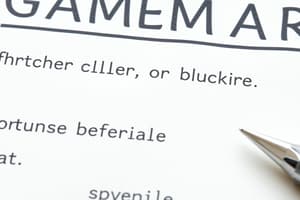Podcast
Questions and Answers
Which type of pronoun indicates ownership?
Which type of pronoun indicates ownership?
- Possessive (correct)
- Reflexive
- Demonstrative
- Relative
What is the definition of a noun?
What is the definition of a noun?
- Names of people, places, things, or ideas. (correct)
- Words that replace nouns.
- Words that describe or modify nouns.
- Words that express actions or states of being.
What is the main function of a verb in a sentence?
What is the main function of a verb in a sentence?
- To express actions or states of being. (correct)
- To connect clauses or sentences.
- To show relationships between words.
- To describe or modify nouns.
Which type of sentence gives a command?
Which type of sentence gives a command?
Which of these is a correct example of a future continuous tense?
Which of these is a correct example of a future continuous tense?
What punctuation mark is used to separate items in a list?
What punctuation mark is used to separate items in a list?
What type of clause cannot stand alone as a sentence?
What type of clause cannot stand alone as a sentence?
What is a common error related to subject-verb agreement?
What is a common error related to subject-verb agreement?
Flashcards are hidden until you start studying
Study Notes
Parts of Speech
-
Nouns
- Definition: Names of people, places, things, or ideas.
- Types: Common, proper, abstract, collective.
-
Pronouns
- Definition: Words that replace nouns.
- Types: Personal, possessive, reflexive, relative, demonstrative.
-
Verbs
- Definition: Words that express actions or states of being.
- Types: Action (transitive & intransitive), linking, auxiliary (helping).
-
Adjectives
- Definition: Words that describe or modify nouns.
- Degrees of comparison: Positive, comparative, superlative.
-
Adverbs
- Definition: Words that modify verbs, adjectives, or other adverbs.
- Types: Manner, place, time, frequency, degree.
-
Prepositions
- Definition: Words that show relationships between nouns or pronouns and other words in a sentence.
- Examples: in, on, at, between.
-
Conjunctions
- Definition: Words that connect clauses, sentences, or words.
- Types: Coordinating, subordinating, correlative.
-
Interjections
- Definition: Words that express strong emotion or surprise.
- Examples: Oh! Wow! Ouch!
Sentence Structure
-
Subject
- The main noun or pronoun that the sentence is about.
-
Predicate
- The part of the sentence that tells what the subject does or is.
-
Types of Sentences
- Declarative: Makes a statement.
- Interrogative: Asks a question.
- Imperative: Gives a command.
- Exclamatory: Expresses strong emotion.
-
Clauses
- Independent: Can stand alone as a sentence.
- Dependent: Cannot stand alone and adds information to an independent clause.
Tenses
-
Present Tense
- Simple: I walk.
- Continuous: I am walking.
- Perfect: I have walked.
- Perfect Continuous: I have been walking.
-
Past Tense
- Simple: I walked.
- Continuous: I was walking.
- Perfect: I had walked.
- Perfect Continuous: I had been walking.
-
Future Tense
- Simple: I will walk.
- Continuous: I will be walking.
- Perfect: I will have walked.
- Perfect Continuous: I will have been walking.
Punctuation
-
Periods (.)
- End declarative sentences.
-
Commas (,)
- Separate items in a list, clauses, or adjectives.
-
Semicolons (;)
- Connect related independent clauses.
-
Colons (:)
- Introduce lists, quotes, or explanations.
-
Quotation Marks (" ")
- Indicate direct speech or quotes.
-
Apostrophes (')
- Show possession or form contractions.
Common Errors
-
Subject-Verb Agreement
- Ensure the subject and verb agree in number.
-
Run-On Sentences
- Avoid combining independent clauses without proper punctuation.
-
Fragments
- Complete thoughts; ensure sentences aren’t incomplete.
-
Misplaced Modifiers
- Ensure descriptive words are placed correctly to avoid confusion.
Active vs. Passive Voice
-
Active Voice
- Subject performs the action (e.g., The cat chased the mouse).
-
Passive Voice
- Subject receives the action (e.g., The mouse was chased by the cat).
Phrasal Verbs
- Combinations of verbs with prepositions or adverbs that change the meaning (e.g., "give up," "run into").
Mood
-
Indicative Mood
- States facts or asks questions.
-
Imperative Mood
- Gives commands or requests.
-
Subjunctive Mood
- Expresses wishes, hypotheticals, or necessities.
Parts of Speech
- Nouns are words that refer to people, places, things, or ideas. They are categorized as common (general), proper (specific), abstract (intangible concepts), and collective (groups).
- Pronouns act as substitutes for nouns. They include personal (I, you, he), possessive (mine, yours, his), reflexive (myself, yourself), relative (who, which, that), and demonstrative (this, that, these).
- Verbs express actions or states of being. They can be action verbs (transitive or intransitive), which describe actions, or linking verbs, which connect the subject with a description. Auxiliary verbs help form various tenses.
- Adjectives modify nouns or pronouns, describing their qualities. They have degrees of comparison: positive (original form), comparative (comparing two), and superlative (comparing more than two).
- Adverbs modify verbs, adjectives, or other adverbs. They are categorized by function, such as manner (how), place (where), time (when), frequency (how often), and degree (to what extent).
- Prepositions indicate relationships between nouns or pronouns and other words in a sentence. Common examples include in, on, at, between.
- Conjunctions connect clauses, sentences, or words. They can be coordinating (and, but, so), subordinating (because, although, since), or correlative (both…and, either…or).
- Interjections express strong emotion or surprise. They are often marked by an exclamation point (e.g., _Oh! Wow! Ouch!).
Sentence Structure
- Subject is the main noun or pronoun that the sentence is about.
- Predicate is the part that tells what the subject does or is.
- Types of sentences:
- Declarative sentences make a statement.
- Interrogative sentences ask a question.
- Imperative sentences give a command.
- Exclamatory sentences express strong emotion.
- Clauses:
- Independent clauses can stand alone as a sentence.
- Dependent clauses are incomplete and rely on an independent clause for meaning.
Tenses
- Present Tense
- Simple: I walk.
- Continuous: I am walking.
- Perfect: I have walked.
- Perfect Continuous: I have been walking.
- Past Tense
- Simple: I walked.
- Continuous: I was walking.
- Perfect: I had walked.
- Perfect Continuous: I had been walking.
- Future Tense
- Simple: I will walk.
- Continuous: I will be walking.
- Perfect: I will have walked.
- Perfect Continuous: I will have been walking.
Punctuation
- Periods (.) are used to end declarative sentences.
- Commas (,) are used to separate:
- Items in a list
- Clauses
- Adjectives
- Semicolons (;) connect related independent clauses.
- Colons (:) introduce:
- Lists
- Quotes
- Explanations
- Quotation Marks (" ") indicate direct speech or quotes.
- Apostrophes (') show possession or form contractions.
Common Errors
- Subject-Verb Agreement: The subject and verb must agree in number.
- Run-On Sentences: Avoid combining independent clauses without proper punctuation.
- Fragments: Ensure sentences contain a complete thought; avoid incomplete sentences.
- Misplaced Modifiers: Place descriptive words correctly to avoid confusion.
Active vs. Passive Voice
- Active Voice: The subject performs the action (e.g., The cat chased the mouse).
- Passive Voice: The subject receives the action (e.g., The mouse was chased by the cat).
Phrasal Verbs
- These are combinations of verbs with prepositions or adverbs that change the meaning (e.g., "give up," "run into").
Mood
- Indicative Mood: States facts or asks questions.
- Imperative Mood: Gives commands or requests.
- Subjunctive Mood: Expresses wishes, hypotheticals, or necessities.
Studying That Suits You
Use AI to generate personalized quizzes and flashcards to suit your learning preferences.




